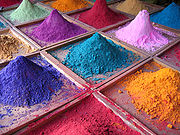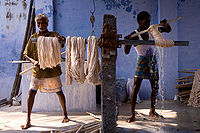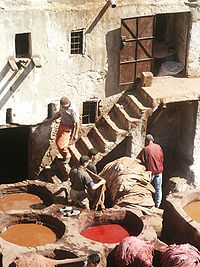
Dyeing
Encyclopedia


Textile
A textile or cloth is a flexible woven material consisting of a network of natural or artificial fibres often referred to as thread or yarn. Yarn is produced by spinning raw fibres of wool, flax, cotton, or other material to produce long strands...
products like fiber
Fiber
Fiber is a class of materials that are continuous filaments or are in discrete elongated pieces, similar to lengths of thread.They are very important in the biology of both plants and animals, for holding tissues together....
s, yarn
Yarn
Yarn is a long continuous length of interlocked fibres, suitable for use in the production of textiles, sewing, crocheting, knitting, weaving, embroidery and ropemaking. Thread is a type of yarn intended for sewing by hand or machine. Modern manufactured sewing threads may be finished with wax or...
s, and fabric
Fabric
A fabric is a textile material, short for "textile fabric".Fabric may also refer to:*Fabric , the spatial and geometric configuration of elements within a rock*Fabric , a nightclub in London, England...
s. Dyeing is normally done in a special solution
Solution
In chemistry, a solution is a homogeneous mixture composed of only one phase. In such a mixture, a solute is dissolved in another substance, known as a solvent. The solvent does the dissolving.- Types of solutions :...
containing dye
Dye
A dye is a colored substance that has an affinity to the substrate to which it is being applied. The dye is generally applied in an aqueous solution, and requires a mordant to improve the fastness of the dye on the fiber....
s and particular chemical material
Material
Material is anything made of matter, constituted of one or more substances. Wood, cement, hydrogen, air and water are all examples of materials. Sometimes the term "material" is used more narrowly to refer to substances or components with certain physical properties that are used as inputs to...
. After dyeing, dye molecules have uncut Chemical bond
Chemical bond
A chemical bond is an attraction between atoms that allows the formation of chemical substances that contain two or more atoms. The bond is caused by the electromagnetic force attraction between opposite charges, either between electrons and nuclei, or as the result of a dipole attraction...
with fiber molecules. The temperature
Temperature
Temperature is a physical property of matter that quantitatively expresses the common notions of hot and cold. Objects of low temperature are cold, while various degrees of higher temperatures are referred to as warm or hot...
and time controlling are two key factors in dyeing. There are mainly two classes of dye, natural and man-made.
For most of the thousands of years in which dyeing has been used by humans to decorate clothing
Clothing
Clothing refers to any covering for the human body that is worn. The wearing of clothing is exclusively a human characteristic and is a feature of nearly all human societies...
, or fabrics for other uses, the primary source of dye has been nature
Nature
Nature, in the broadest sense, is equivalent to the natural world, physical world, or material world. "Nature" refers to the phenomena of the physical world, and also to life in general...
, with the dyes being extracted from animal
Animal
Animals are a major group of multicellular, eukaryotic organisms of the kingdom Animalia or Metazoa. Their body plan eventually becomes fixed as they develop, although some undergo a process of metamorphosis later on in their life. Most animals are motile, meaning they can move spontaneously and...
s or plant
Plant
Plants are living organisms belonging to the kingdom Plantae. Precise definitions of the kingdom vary, but as the term is used here, plants include familiar organisms such as trees, flowers, herbs, bushes, grasses, vines, ferns, mosses, and green algae. The group is also called green plants or...
s. In the last 150 years, humans have produced artificial dyes to achieve a broader range of colors, and to render the dyes more stable to resist washing and general use. Different classes of dyes are used for different types of fiber and at different stages of the textile production process, from loose fibers through yarn and cloth to completed garments.
Acrylic fibers are dyed with basic dyes, Nylon and protein fibers such as wool and silk are dyed with acid dyes, polyester yarn is dyed with disperse dyes. Cotton is dyed with a range of dye types, including vat dyes, and modern synthetic reactive and direct dyes.
History
Archaeologists have found evidence of textileTextile
A textile or cloth is a flexible woven material consisting of a network of natural or artificial fibres often referred to as thread or yarn. Yarn is produced by spinning raw fibres of wool, flax, cotton, or other material to produce long strands...
dyeing dating back to the Neolithic
Neolithic
The Neolithic Age, Era, or Period, or New Stone Age, was a period in the development of human technology, beginning about 9500 BC in some parts of the Middle East, and later in other parts of the world. It is traditionally considered as the last part of the Stone Age...
period. The earliest surviving evidence of textile dyeing was found at the large Neolithic
Neolithic
The Neolithic Age, Era, or Period, or New Stone Age, was a period in the development of human technology, beginning about 9500 BC in some parts of the Middle East, and later in other parts of the world. It is traditionally considered as the last part of the Stone Age...
settlement at Çatalhöyük
Çatalhöyük
Çatalhöyük was a very large Neolithic and Chalcolithic settlement in southern Anatolia, which existed from approximately 7500 BCE to 5700 BCE...
in southern Anatolia
Anatolia
Anatolia is a geographic and historical term denoting the westernmost protrusion of Asia, comprising the majority of the Republic of Turkey...
, where traces of red dyes, possible from ochre
Ochre
Ochre is the term for both a golden-yellow or light yellow brown color and for a form of earth pigment which produces the color. The pigment can also be used to create a reddish tint known as "red ochre". The more rarely used terms "purple ochre" and "brown ochre" also exist for variant hues...
(iron oxide
Iron oxide
Iron oxides are chemical compounds composed of iron and oxygen. All together, there are sixteen known iron oxides and oxyhydroxides.Iron oxides and oxide-hydroxides are widespread in nature, play an important role in many geological and biological processes, and are widely utilized by humans, e.g.,...
pigment
Pigment
A pigment is a material that changes the color of reflected or transmitted light as the result of wavelength-selective absorption. This physical process differs from fluorescence, phosphorescence, and other forms of luminescence, in which a material emits light.Many materials selectively absorb...
s from clay
Clay
Clay is a general term including many combinations of one or more clay minerals with traces of metal oxides and organic matter. Geologic clay deposits are mostly composed of phyllosilicate minerals containing variable amounts of water trapped in the mineral structure.- Formation :Clay minerals...
), were found. In China, dyeing with plants, barks and insects has been traced back more than 5,000 years. Early evidence of dyeing comes from Sindh (Pakistan), where a piece of cotton dyed with a vegetable dye has been recovered from the archaeological site at Mohenjo-daro
Mohenjo-daro
Mohenjo-daro is an archeological site situated in what is now the province of Sindh, Pakistan. Built around 2600 BC, it was one of the largest settlements of the ancient Indus Valley Civilization, and one of the world's earliest major urban settlements, existing at the same time as the...
(3rd millennium BCE). The dye used in this case was madder
Rubiá
aRubiá is a municipality in the Spanish province of Ourense. It has a population of 1734 and an area of 101 km²....
, which, along with other dyes such as indigo
Indigo dye
Indigo dye is an organic compound with a distinctive blue color . Historically, indigo was a natural dye extracted from plants, and this process was important economically because blue dyes were once rare. Nearly all indigo dye produced today — several thousand tons each year — is synthetic...
, was introduced to other regions through trade. Natural insect dyes such as Tyrian purple
Tyrian purple
Tyrian purple , also known as royal purple, imperial purple or imperial dye, is a purple-red natural dye, which is extracted from sea snails, and which was possibly first produced by the ancient Phoenicians...
and kermes
Kermes (dye)
Kermes is a red dye derived from the dried bodies the females of a scale insect in the genus Kermes, primarily Kermes vermilio. The insects live on the sap of certain trees, especially Kermes oak tree near the Mediterranean region...
and plant-based dyes such as woad, indigo and madder were important elements of the economies of Asia and Europe until the discovery of man-made synthetic dye
Dye
A dye is a colored substance that has an affinity to the substrate to which it is being applied. The dye is generally applied in an aqueous solution, and requires a mordant to improve the fastness of the dye on the fiber....
s in the mid-19th century. The first synthetic dyes was William Perkins
William Perkins
William Perkins was a clergyman and Cambridge theologian who was one of the foremost leaders of the Puritan movement in the Church of England.-Early life:...
's mauveine
Mauveine
Mauveine, also known as aniline purple and Perkin's mauve, was the first synthetic organic chemical dye.Its chemical name is3-amino-2,±9-dimethyl-5-phenyl-7-phenazinium acetate...
in 1856, derived from coal tar
Coal tar
Coal tar is a brown or black liquid of extremely high viscosity, which smells of naphthalene and aromatic hydrocarbons. Coal tar is among the by-products when coal iscarbonized to make coke or gasified to make coal gas...
. Alizarin
Alizarin
Alizarin or 1,2-dihydroxyanthraquinone is an organic compound with formula that has been used throughout history as a prominent dye, originally derived from the roots of plants of the madder genus.Alizarin was used as a red dye for the English parliamentary "new model" army...
, the red dye present in madder, was the first natural pigment to be duplicated synthetically, in 1869, a development which led to the collapse of the market for naturally grown madder. The development of new, strongly colored synthetic dyes followed quickly, and by the 1870s commercial dyeing wth natural dyestuffs was disappearing.
Methods

Direct application
The term "direct dye application" stems from some dyestuff having to be either fermented as in the case of some natural dye or chemically reducedRedox
Redox reactions describe all chemical reactions in which atoms have their oxidation state changed....
as in the case of synthetic vat and sulfur dyes before being applied. This renders the dye soluble so that it can be absorbed by the fiber since the insoluble dye has very little substantivity to the fiber. Direct dyes, a class of dyes largely for dyeing cotton, are water soluble and can be applied directly to the fiber from an aqueous solution. Most other classes of synthetic dye, other than vat and surface dyes, are also applied in this way.
The term may also be applied to dyeing without the use of mordant
Mordant
A mordant is a substance used to set dyes on fabrics or tissue sections by forming a coordination complex with the dye which then attaches to the fabric or tissue. It may be used for dyeing fabrics, or for intensifying stains in cell or tissue preparations. The term mordant comes from the Latin...
s to fix the dye once it is applied. Mordants were often required to alter the hue and intensity of natural dyes and improve their color fastness. Chromium
Chromium
Chromium is a chemical element which has the symbol Cr and atomic number 24. It is the first element in Group 6. It is a steely-gray, lustrous, hard metal that takes a high polish and has a high melting point. It is also odorless, tasteless, and malleable...
salts were until recently extensively used in dying wool with synthetic mordant dyes. These were used for economical high color fastness dark shades such as black and navy
Navy blue
Navy blue is a very dark shade of the color blue which almost appears as black. Navy blue got its name from the dark blue worn by officers in the British Royal Navy since 1748 and subsequently adopted by other navies around the world....
. Environmental concern has now restricted their use, and they have been replaced with reactive and metal complex dyes which need no mordant.
Yarn dyeing
There are many forms of yarn dyeing. Common forms are the at package form and the at hanks form. Cotton yarns are mostly dyed at package form, and acrylic or wool yarn are dyed at hank form. In the continuous filament industry, polyester or polyamide yarns are always dyed at package form, while viscose rayon yarns are partly dyed at hank form because of technology.The common dyeing process of cotton yarn with reactive dyes at package form is as follows:
- The raw yarn is wound on a spring tube to achieve a package suitable for dye penetration.
- These softened packages are loaded on a dyeing carrier's spindle one on another.
- The packages are pressed up to a desired height to achieve suitable density of packing.
- The carrier is loaded on the dyeing machine and the yarn is dyed.
- After dyeing, the packages are unloaded from the carrier into a trolly.
- Now the trolly is taken to hydro extractor where water is removed.
- The packages are hydro extracted to remove the maximum amount of water leaving the desired color into raw yarn.
- The packages are then dried to achieve the final dyed package.₪
After this process, the dyed yarn packages are packed and delivered.

